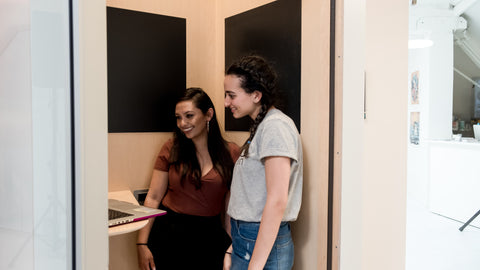Office design is constantly evolving and as design trends come and go, so too do different styles of working in an office environment. The workplace has become more flexible – it’s no longer the case that employees are expected to sit at their desk or cubicle from 9 to 5.
While the open office and hot-desking first found popularity in the ‘90s, from the year 2000 and beyond, offices started to become more playful and fun to reflect the younger and more entrepreneurial workforce and the growing importance on work-life balance.
Almost two decades later, these concepts have become more refined, resulting in what has commonly become known as “Millennial” office design – taking its name from the Millennial generation born between 1981 and 1996. Millennials are predicted to make up 35% of the global workforce by 2020.

What Is Millennial Office Design?
To understand exactly what Millennial design looks like, it makes sense to first understand the characteristics and motivations of the Millennial generation.
This is the first generation to have grown up with the internet as a part of their lives from childhood – they’ve basically never known a world without mobile phones, being constantly online, and the ability to access information instantly at any time of the day or night.
Millennials as a group are ambitious, creative, and technically sophisticated. They want a career and not just a paycheck, and they’re more willing than previous generations to jump ship to another company if they’re not happy at work. In fact, Millennials rate work-life balance as the most important factor when it comes to evaluating job opportunities.
So how do these characteristics and motivations translate into office design?
- Collaborative workspaces – Millennials have a lower need for privacy than previous generations and often work well in a collaborative environment.
- Flexible work zones – rather than separating workspaces by seniority or even department, workers may be offered a variety of different places to work to suit different tasks and personality types.
- Smaller workspaces – technology is shrinking and no longer requires a big space at each workstation. Instead, the focus is on utilizing the space available in a better way. Companies are also embracing flexible working practices, which means they may not need space for all employees to work from the office every day.
- Modular systems – this includes flexible office layouts that can be adjusted and moved around to create larger or smaller offices as needed, and that will grow with the team.
- Mixed purpose common areas – employees are no longer expected to be chained to their desks and employers have recognized that a traditional workstation or meeting room is not the best place for collaboration and creativity. Break and social areas can double-up as less formal workspaces to inspire conversation and creative thinking in a more relaxed environment.
- Semi-open design – completely open-plan offices don’t necessarily translate into the most productive work environment for everyone. Instead, companies are providing a mixture of collaborative open environments and quiet spaces for distraction-free work that requires concentration. One solution that works well is installing small work booths inside open-plan offices to provide privacy for phone calls and focused work without the noise and distractions of the open environment.
So what are the main advantages of this type of millennial workspace?
1. Smaller Offices and Lower Rents
As workstations and technology are shrinking, and multi-use common areas are growing, today’s businesses can work well in an office space with a much smaller square footage than what would have been previously recommended.
This not only means that there’s less of a hit on company profits due to lower rents, but also that small to medium size businesses may be able to afford offices in city centers or other highly sought after locations.
2. More Flexibility for Today’s Rapidly Changing Environment
A successful business will grow in team size, not just revenue or profit. Today’s more flexible approach to office design means you don’t necessarily have to move on when you outgrow your office.
Clever use of space and more flexible working practices mean that growing teams can stay in the same space for longer.
This flexibility also means that the office space can be rearranged to suit the needs of employees and projects as they change over time.
3. A Sanctuary from Distractions
Open plan offices are useful for collaboration and you can fit more employees into one space. However, the visual and auditory distractions caused by this type of work environment can have a big negative impact on productivity, and can even result in increases to employee stress.
Designated quiet zones and enclosed office workspaces such as the Zenbooth provide a quiet, distraction-free location for work that needs deep concentration. The result is happier and more productive employees.
4. A Better Work-Life Balance
Taking into account employees’ emotional, mental, and physical needs as well as simply providing them with a work-friendly environment benefits everyone.
Millennial workspaces with adequate areas for resting, socializing and collaborating help to improve all aspects of employee health.
Happier and healthier employees are not only more productive and take fewer sick days, but they’re also more likely to stay and work for a company that considers all their needs.
When social time, rest, and play are also encouraged by providing spaces for these activities, people are happier to stay at the office longer and there’s no overwhelming need to escape as soon as the clock strikes 5 pm.

Millennial Office Design Benefits Everyone
Smart, modern, flexible working spaces not only provide a better working environment for employees, but also translate into higher efficiency and productivity, with lower costs for business owners.
If your office hasn’t been renovated in the last few years, it may well be time to invest in your company workspace and start reaping the benefits.